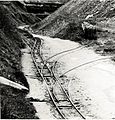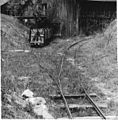Plasterwork
A gypsum plant is an industrial company in which gypsum and gypsum products are produced from the raw gypsum raw material after burning at a relatively low temperature , which are mainly used in interior construction . Gypsum works can only be found in the immediate vicinity of a gypsum deposit; In Germany these occur mainly in the geological groups Muschelkalk , Keuper and Zechstein .
A gypsum works consists of the gypsum pit, in which the gypsum stone is extracted in the opencast or underground , a means of transport to the crushing plant and the kiln and the kiln itself with a gypsum mill . The finished plaster is mostly processed in the plaster works itself, for example into plaster of different specifications or plasterboard .
Historical
Pre-industrial
The Federal Association of the Gypsum Industry has a well-founded article on the Internet about the more than 10,000-year history of gypsum and its use.
Where plaster of paris was available, plaster of paris was also used as a substitute for stone in the late Middle Ages , for example in Rottweil for window reveals on town houses.
19th and 20th centuries
At the beginning of the 20th century there were countless small plaster works in the areas with pending gypsum stone, often several in the same village. Due to the exhaustion of the profitable deposits and the increasing concentration in the industry, most of the small gypsum works have been closed since the 1960s. A few large, internationally operating companies dominate the market today.
A small plaster work
The gypsum plant between the Ammertal communities Entringen and Breitenholz (near Tübingen ), which was put into operation in 1910 and closed in the 1970s, may serve as an example of a small gypsum plant. The former gypsum pit has been used as a landfill ever since and has now largely been filled.
The gypsum works mined the raw gypsum found in the gypsum keuper. Some of the mining took place underground; The raw plaster of paris was transported to the kiln with the help of a factory railway ( field railway gauge 600 mm). The finished plaster was brought to Breitenholz station via a 1.5 km long field railway, from where the coal required for heating came from.
The schematic drawing shows the course of the track. The two tracks for the delivery of raw gypsum and coal led via ramps to the upper floor of the gypsum works. The loaded wagons were pulled up with the help of rope winches. The gypsum pit itself consisted of two floors, each with a track. On the lower level, former tunnel mouth holes from mining operations can be seen.
Large enterprise
The increasing concentration on the building materials sector has not only led to many company closings but also to the expansion of individual companies. The Kayh gypsum plant , not far from the disused Entringer gypsum plant, became a Knauf Gips logistics center .
The picture of the gypsum works in Cumbria, England, shows the importance of the processing of the gypsum (many production halls) and road transport (trucks in the parking lot in the foreground) today.
In addition to the raw gypsum obtained in gypsum pits, gypsum that is obtained in flue gas desulphurisation ( FGD gypsum ) has recently been increasingly processed .
swell
- ↑ Archive link ( Memento of the original from September 29, 2007 in the Internet Archive ) Info: The archive link was inserted automatically and has not yet been checked. Please check the original and archive link according to the instructions and then remove this notice. J. Stark, From the History of Gypsum
- ↑ Archive link ( Memento of the original from September 27, 2007 in the Internet Archive ) Info: The archive link was inserted automatically and has not yet been checked. Please check the original and archive link according to the instructions and then remove this notice. R. Dendler, S. King, window reveals made of stucco in Rottweil, from high and late medieval stucco, 2002





